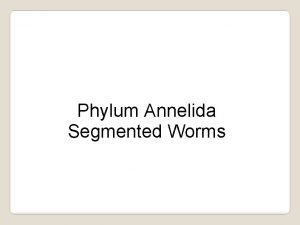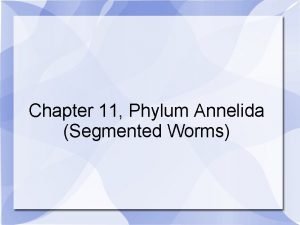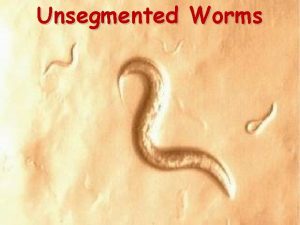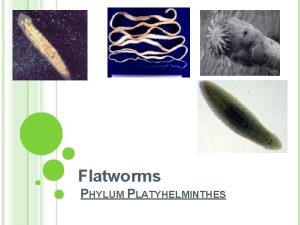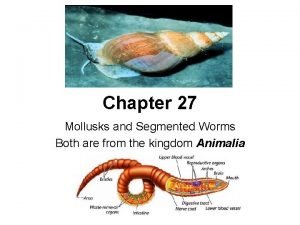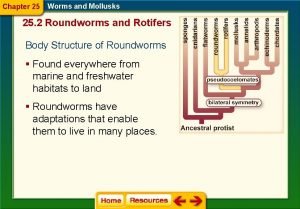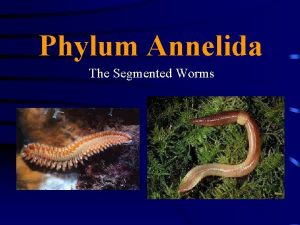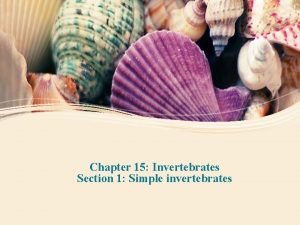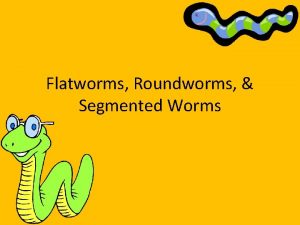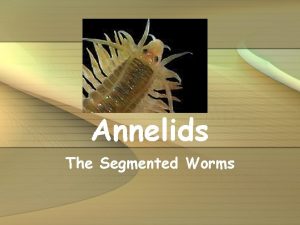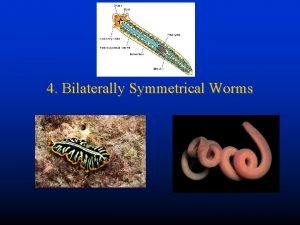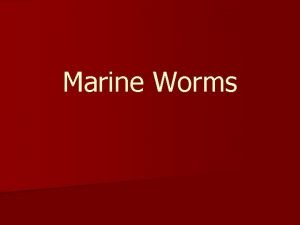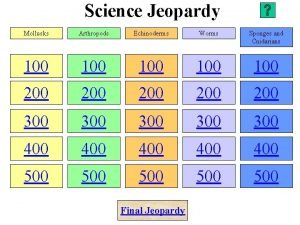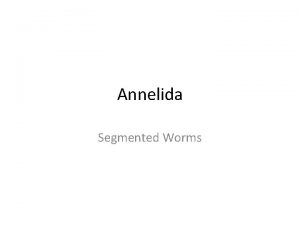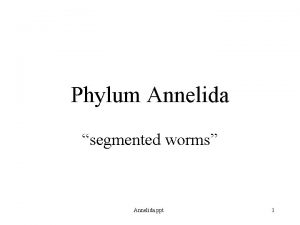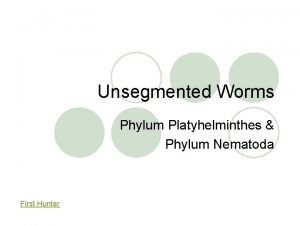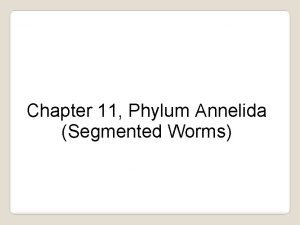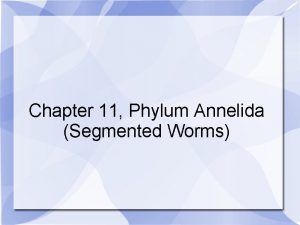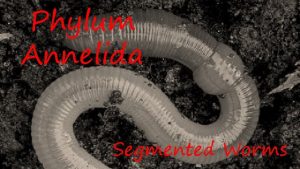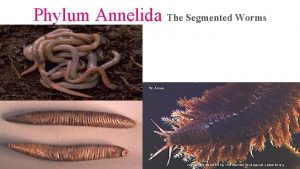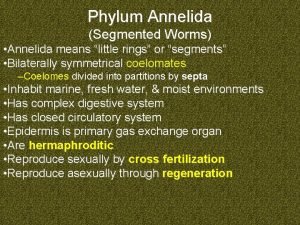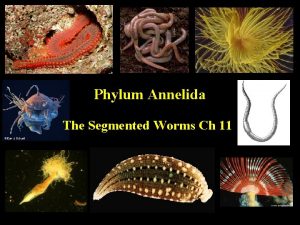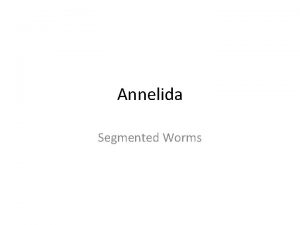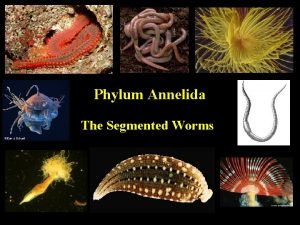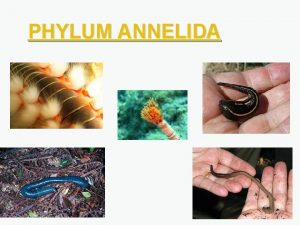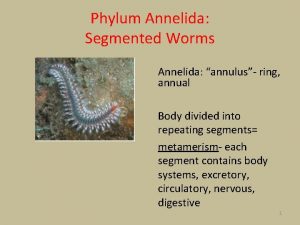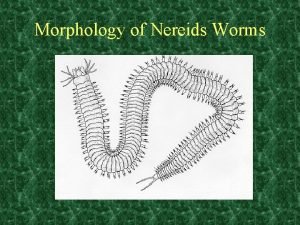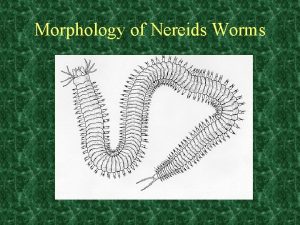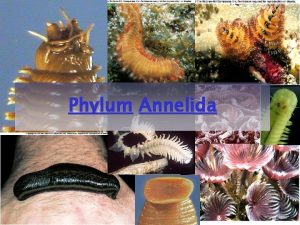Phylum Annelida segmented worms Annelida ppt 1 Phylum

















- Slides: 17

Phylum Annelida “segmented worms” Annelida. ppt 1

Phylum Annelida • Segmented round worms • Parapodia – each segment has extentions of bristles called Setae • Body systems are also segmented (repeating) • Bigger /more complex requires better gas exchange (some w/ gills), and circulation (closed)

Next Big Advance • Coelom (body cavity) • Body Segmentation • Closed Circulatory system • 2 major groups depending on how coelom formed and how the embryo develops – Protostomes – Deuterostomes

Annelida 27 March 2013 Annelida. ppt 4

Copyright ©The Mc. Graw-Hill Companies, Inc. Permission required for reproduction or display ANNELIDA Class Polychaeta • Family Amphinomidae • Bearded fireworm (Hermodice carunculata) • White bristles, extended in defense, are venomous Photo Copyright © Diane R. Nelson Setae

Phylum Annelida • ~ 9000 species • Segmentation highly developed – Mesodermal “blocks, ” each with own coelom – Septa between segments 27 March 2013 Annelida. ppt 6

Phylum Annelida • Hydrostatic skeleton – – Fluid pressure in coelom provides support & locomotion Circular muscles Longitudinal muscles Peristaltic locomotion 27 March 2013 Annelida. ppt 7

Function of a hydrostatic skeleton 27 March 2013 Annelida. ppt 8

Phylum Annelida • Setae (“bristles”) of chitin – “anchors” for earthworm – “paddles” for polychaete – Enlarged as jaws in leeches, some polychaetes 27 March 2013 Annelida. ppt 9

Phylum Annelida • Closed circulatory system – Multiple “hearts” – Hemoglobin not in blood cells • reddish-pink color 27 March 2013 Annelida. ppt 10

Phylum Annelida • Central nervous system – Dorsal brain – Pair of nerves on sides of esophagus – Paired ventral nerve cords with paired ganglia in each segment – Transverse nerves connect ganglia in each segment 27 March 2013 Annelida. ppt 11

Phylum Annelida • Earthworms’ paired nerve cords are fused into single ventral cord • Arthropod better illustrates primitive nervous system of both phyla. 27 March 2013 Annelida. ppt 12

Phylum Annelida • Class Polychaetes – “many setae, ” clusters with 20+ setae – parapodia 27 March 2013 Annelida. ppt 13

Phylum Annelida • Class Earthworms – few setae in 2 -4 clusters per segment – Clitellum – stores fertilized eggs until they hatch – Reproduce Sexually – Can regenerate Annelida. ppt 14

Phylum Annelida • Class Leeches – – pair of bladelike “jaws” posterior “suction cup” Predators External parasites, “bloodsuckers” • Secrete anticoagulants • Medicinal use 27 March 2013 Annelida. ppt 15

Phylum Annelida • Leeches – Hirudin from leech, Hirudo medicinalis, inhibits blood clotting 27 March 2013 Annelida. ppt 16

Annelids Cont’ 27 March 2013 Annelida. ppt 17
 How do earthworms reproduce
How do earthworms reproduce Features of segmented worms
Features of segmented worms Flatworms belong to which phylum
Flatworms belong to which phylum Unsegmented worms
Unsegmented worms Are worms mollusks
Are worms mollusks Chapter 25 section 3 mollusks
Chapter 25 section 3 mollusks Segmented worms characteristics
Segmented worms characteristics Segmented worms
Segmented worms Phylum platyhelminthes segmentation
Phylum platyhelminthes segmentation Segmented worms characteristics
Segmented worms characteristics Symmetry of worms
Symmetry of worms Segmented worms symmetry
Segmented worms symmetry 5 advanced characteristics shared by cephalopods
5 advanced characteristics shared by cephalopods Chapter 27 worms and mollusks
Chapter 27 worms and mollusks The segmental arrangement of body parts
The segmental arrangement of body parts Annelida
Annelida Unsegmented roundworms
Unsegmented roundworms Nematoda segmentation
Nematoda segmentation
